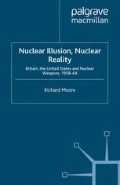Abstract
The story of Britain’s nuclear-weapons programme is a complex one, and a great deal happened during the six years covered in this study. Some distillation is required before we can address, for example, the motivations behind Britain’s massive effort to achieve and maintain a credible nuclear capability. Several essentially political issues were central to the story: the long quest for a measure of nuclear test limitation; concern over American bases in the UK, reaching a peak during the Holy Loch negotiations; and the twin cancellation crises of Blue Streak in 1960, and Skybolt in 1962. Each of these issues made the achievement of a credible nuclear capability more difficult, and each was solved with American help. The test moratorium of 1958–61, for example, made it impossible in the short term fully to engineer, for weapons use, the advanced British nuclear warhead designs of the Grapple-Z series. British scientists had mastered tritium boosting and the two-stage H-bomb using radiation implosion, but without testing they could take that theoretical knowledge only so far. President Eisenhower was sympathetic enough to modify the US Atomic Energy Act and authorise the July 1958 bilateral agreement to allow Britain to use engineered US warhead designs. American atomic scientists were meanwhile interested and impressed enough by British progress to forge a productive relationship with Aldermaston over the following several years.
Access this chapter
Tax calculation will be finalised at checkout
Purchases are for personal use only
Preview
Unable to display preview. Download preview PDF.
Notes
See e.g., David A Rosenberg, ‘Arleigh Albert Burke’, in Richard Love, ed., The chiefs of naval operations (US Naval Institute Press 1980), pp. 263–319.
Hubert Zimmermann, Money and security: troops, monetary policy and West Germany’s relations with the United States and Britain, 1950–1971 (Cambridge UP 2002), appendix;
Hugh Hanning, ‘Britain east of Suez — facts and figures’, International Affairs 42/2 (Apr 1966), p. 253.
See Kurt Wayne Schake, ‘Strategic frontier: American bomber bases overseas 1950–60’, dissertation for the Norwegian University of Science and Technology, Jan 1998 (accessible from: http://handle.dtic.mil/100.2/ADA353633), esp. pp. 121–8 and appendix A4. Schake claims that those with the UK were ‘the most permissive base agreements, by far’, although this conclusion appears not to be supported by the evidence he cites: other countries wished to be consulted, before a (unilateral) US decision, or simply expected the US to go ahead without consultation if NATO was at war. For dealings with the French, see US Dept of State, Foreign relations of the United States 1961–3, vol. XIII, pp. 666, 672.
See e.g., Jeffrey A Engel, Cold war at 30,000 feet: the Anglo-American fight for aviation supremacy (Harvard UP 2007); Zimmermann, Money and security;
Francis J Gavin, ‘The gold battles within the cold war: American monetary policy and the defence of Europe 1960–63’, Diplomatic History 26/1 (Winter 2002), pp. 61–94;
Diane B Kunz, ‘“Somewhat mixed up together”: Anglo-American defence and financial policy during the 1960s’, Journal of Imperial and Commonwealth History 27/2 (Spring 1999), pp. 213–32.
Frank Barnett-Jones, TSR.2: phoenix or folly? (Peterborough, GMS 1994), p. 246.
Lewis Page, Lions, donkeys and dinosaurs: waste and blundering in the armed forces (William Heinemann 2006).
Stephen I Schwartz, ed., Atomic audit: the costs and consequences of US nuclear weapons since 1940 (Washington DC, Brookings 1998).
See Andrew Moravcsik, ‘De Gaulle between grain and grandeur: the political economy of French EC policy 1958–70’ (and the several replies thereto), Journal of Cold War Studies 2/2 (Spring 2000), pp. 3–43, and 2/3 (Fall 2000), pp. 4–139.
George Quester, Deterrence before Hiroshima: the airpower background of modern strategy (New York, John Wiley 1966).
Author information
Authors and Affiliations
Copyright information
© 2010 Richard Moore
About this chapter
Cite this chapter
Moore, R. (2010). Conclusions. In: Nuclear Illusion, Nuclear Reality. Nuclear Weapons and International Security since 1945. Palgrave Macmillan, London. https://doi.org/10.1057/9780230251403_6
Download citation
DOI: https://doi.org/10.1057/9780230251403_6
Publisher Name: Palgrave Macmillan, London
Print ISBN: 978-1-349-31163-7
Online ISBN: 978-0-230-25140-3
eBook Packages: Palgrave History CollectionHistory (R0)

